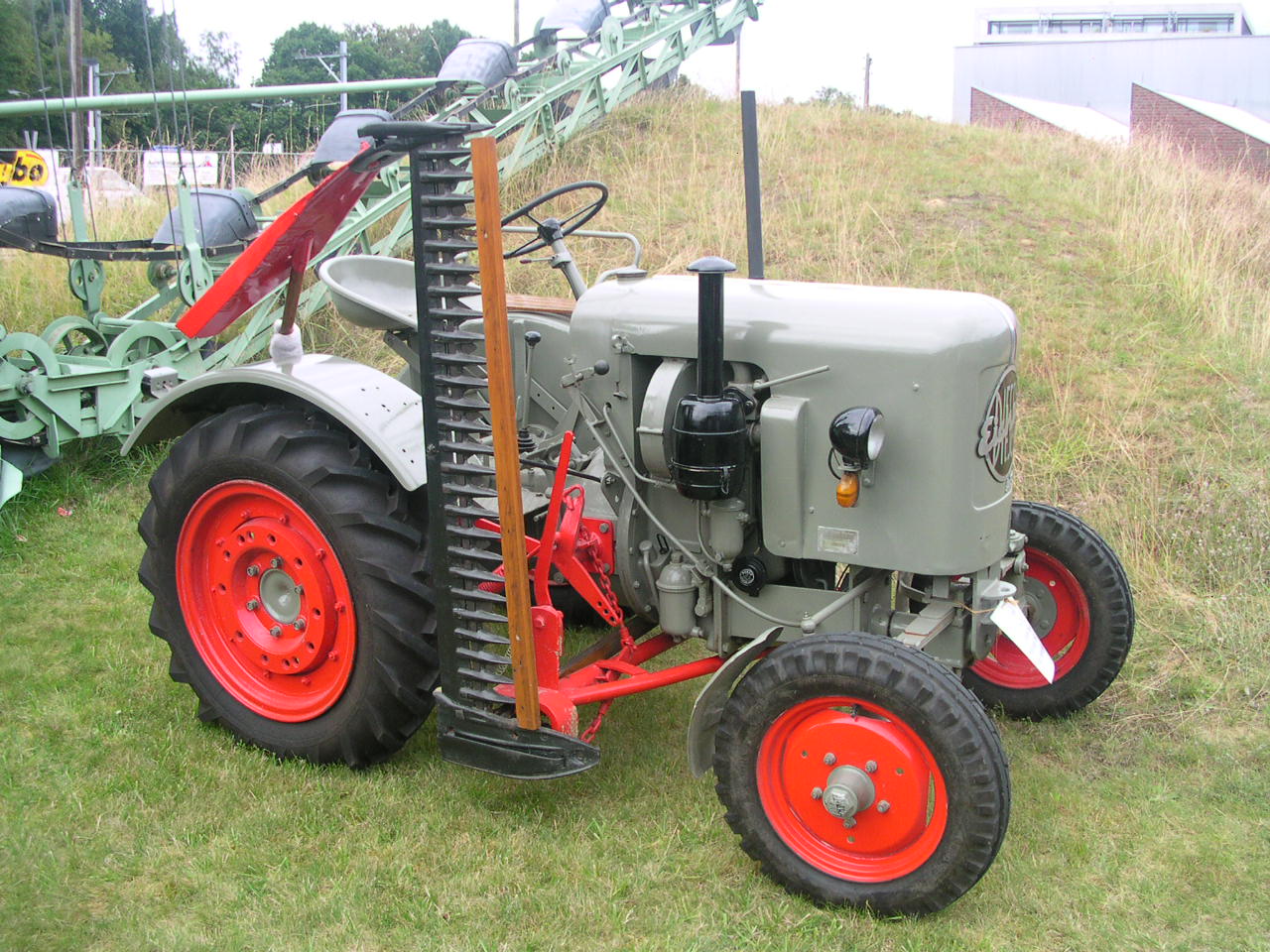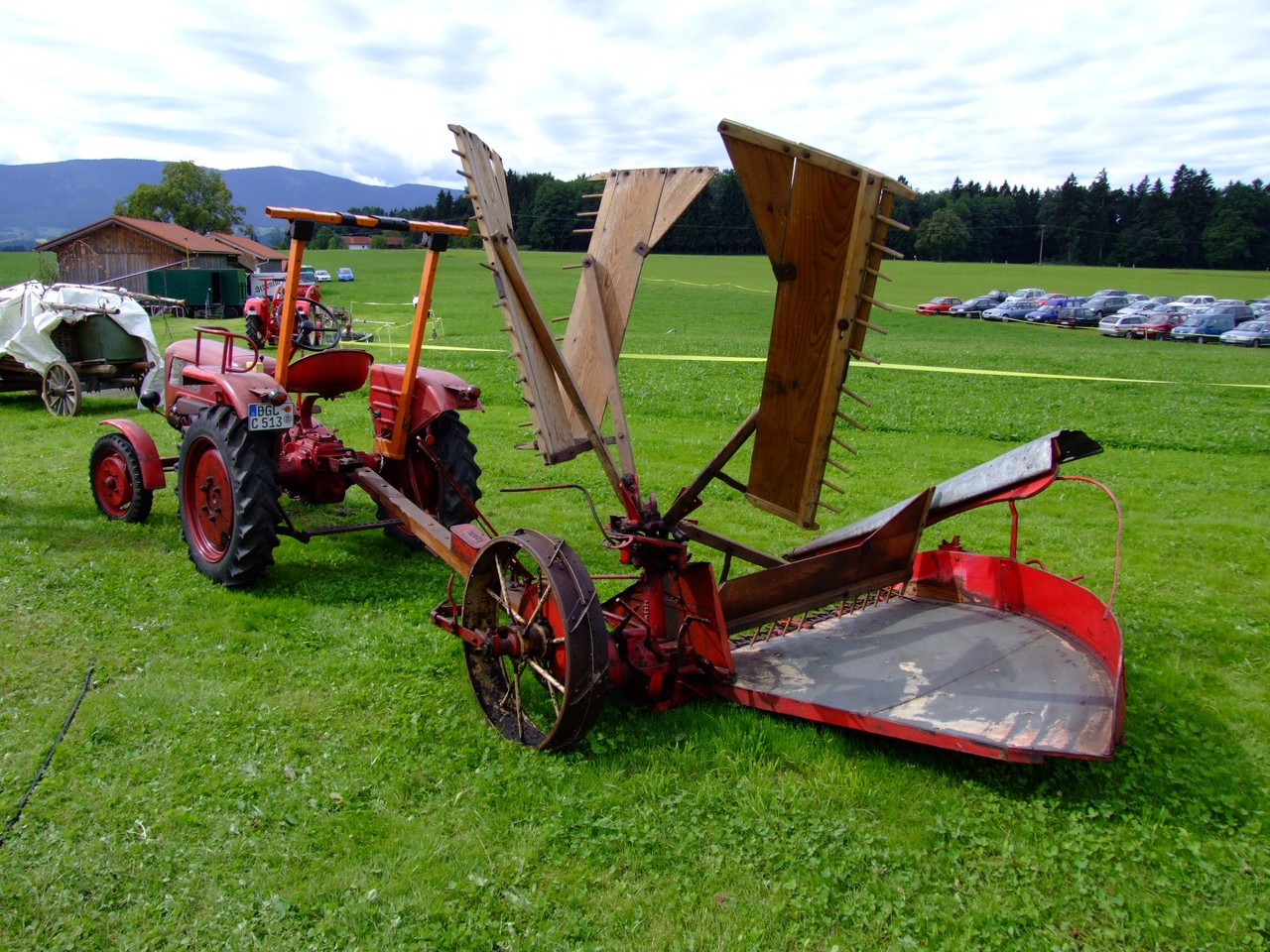|
Mower
A mower is a person or machine that cuts (mows) grass or other plants that grow on the ground. Usually mowing is distinguished from reaping, which uses similar implements, but is the traditional term for harvesting grain crops, e.g. with reapers and combines. A smaller mower used for lawns and sports grounds (playing fields) is called a ''lawn mower'' or ''grounds mower'', which is often self-powered, or may also be small enough to be pushed by the operator. Grounds mowers have reel or rotary cutters. Larger mowers or '' mower-conditioners'' are mainly used to cut grass (or other crops) for hay or silage and often place the cut material into rows, which are referred to as '' windrows''. ''Swathers'' (or ''windrowers'') are also used to cut grass (and grain crops). Prior to the invention and adoption of mechanized mowers, (and today in places where use a mower is impractical or uneconomical), grass and grain crops were cut by hand using scythes or sickles. Mower configuratio ... [...More Info...] [...Related Items...] OR: [Wikipedia] [Google] [Baidu] |
Lawn Mower
A lawn mower (also known as a mower, grass cutter or lawnmower) is a device utilizing one or more revolving blades (or a reel) to cut a grass surface to an even height. The height of the cut grass may be fixed by the design of the mower, but generally is adjustable by the operator, typically by a single master lever, or by a lever or nut and bolt on each of the machine's wheels. The blades may be powered by manual force, with wheels mechanically connected to the cutting blades so that when the mower is pushed forward, the blades spin or the machine may have a battery-powered or plug-in electric motor. The most common self-contained power source for lawn mowers is a small (typically one cylinder) internal combustion engine. Smaller mowers often lack any form of propulsion, requiring human power to move over a surface; "walk-behind" mowers are self-propelled, requiring a human only to walk behind and guide them. Larger lawn mowers are usually either self-propelled "walk-behind" ... [...More Info...] [...Related Items...] OR: [Wikipedia] [Google] [Baidu] |
Conditioner (farming)
A conditioner (or ''hay conditioner'') is a farm implement that crimps and crushes newly cut hay to promote faster and more even drying. Drying the hay efficiently is most important for first cutting of the hay crop, which consists of coarse stalks that take a longer period of time to draw out moisture than finer-textured hays, such as second and subsequent cuttings. A conditioner is made up of two grooved rollers which the hay is forced through, causing the stalks to split, thus allowing the liquid trapped behind cell walls (sap and cell sap) to leak out and also giving more surface area for evaporation. The stand-alone conditioner is no longer used on most farms, since the conditioner has been incorporated into mower-conditioners, which combine the mower and conditioner into a single machine. The names Haybine and Discbine are brand names of mower-conditioners, although some farmers use these names somewhat generically. Mower-conditioners Mower-conditioners are a staple of l ... [...More Info...] [...Related Items...] OR: [Wikipedia] [Google] [Baidu] |
Scythe
A scythe ( ) is an agricultural hand tool for mowing grass or harvesting crops. It is historically used to cut down or reap edible grains, before the process of threshing. The scythe has been largely replaced by horse-drawn and then tractor machinery, but is still used in some areas of Europe and Asia. Reapers are bladed machines that automate the cutting of the scythe, and sometimes subsequent steps in preparing the grain or the straw or hay. The word "scythe" derives from Old English ''siðe''. In Middle English and later, it was usually spelt ''sithe'' or ''sythe''. However, in the 15th century some writers began to use the ''sc-'' spelling as they thought (wrongly) the word was related to the Latin ''scindere'' (meaning "to cut"). Nevertheless, the ''sithe'' spelling lingered and notably appears in Noah Webster's dictionaries. A scythe consists of a shaft about long called a ''snaith'', ''snath'', ''snathe'' or ''sned'', traditionally made of wood but now some ... [...More Info...] [...Related Items...] OR: [Wikipedia] [Google] [Baidu] |
Swather
A swather (North America), or windrower (Australia and rest of world), is a farm implement that cuts hay or small grain crops and forms them into a windrow for drying. They may be self-propelled with an engine, or drawn by a tractor and power take-off powered. A swather uses a reciprocating sickle bar or rotating discs to sever the crop stems. The reel helps cut crop fall neatly onto a canvas or auger conveyor which deposits it into a windrow with stems aligned and supported above the ground by the stubble. A swather does the same task for hay crops as hand scything, cradling and swathing, or mowing and raking. Horizontal rollers behind the cutters may be used to crimp or condition the stems of hay crops to decrease drying time. For grains, as combines replaced threshing machines, the swather introduced an optional step in the harvesting process to provide for the drying time that binding formerly afforded. Swathing is still more common in the northern United Sta ... [...More Info...] [...Related Items...] OR: [Wikipedia] [Google] [Baidu] |
Flail Mower
A flail mower is a type of powered garden/agricultural equipment which is used to deal with heavier grass/scrub which a normal lawn mower could not cope with. Some smaller models are self-powered, but many are PTO driven implements, which can attach to the three-point hitches found on the rear of most tractors. This type of mower is best used to provide a rough cut to long grass and even brambles in locations such as roadsides, where contact with loose debris may be possible. The flail mower gets its name from the use of flails attached to its rotating horizontal drum (also called tube, rotor, or axle). Many implement companies also refer to the flails as knives, blades or hammers. The rows of flails are usually staggered to give a continuous cut for reduced wear on the machine. The flails are attached to the drum using chain links or brackets, depending on the manufacturer. The rotating drum is parallel to the axle of the tractor. The PTO driveshaft along the tractor's axis mus ... [...More Info...] [...Related Items...] OR: [Wikipedia] [Google] [Baidu] |
Reaper
A reaper is a farm implement or person that reaps (cuts and often also gathers) crops at harvest when they are ripe. Usually the crop involved is a cereal grass. The first documented reaping machines were Gallic reapers that were used in Roman times in what would become modern-day France. The Gallic reaper involved a comb which collected the heads, with an operator knocking the grain into a box for later threshing. Most modern mechanical reapers cut grass; most also gather it, either by windrowing or picking it up. Modern machines that not only cut and gather the grass but also thresh its seeds (the grain), winnow the grain, and deliver it to a truck or wagon, called combine harvesters or simply combines, which are the engineering descendants of earlier reapers. Hay is harvested somewhat differently from grain; in modern haymaking, the machine that cuts the grass is called a hay mower or, if integrated with a conditioner, a mower-conditioner. As a manual task, cutti ... [...More Info...] [...Related Items...] OR: [Wikipedia] [Google] [Baidu] |
Robot Mower Helps Flood Defence - Robot Torri Gwair Yn Helpu Amddiffyn Rhag Llifogydd
A robot is a machine—especially one programmable by a computer—capable of carrying out a complex series of actions automatically. A robot can be guided by an external control device, or the control may be embedded within. Robots may be constructed to evoke human form, but most robots are task-performing machines, designed with an emphasis on stark functionality, rather than expressive aesthetics. Robots can be autonomous or semi-autonomous and range from humanoids such as Honda's ''Advanced Step in Innovative Mobility'' ( ASIMO) and TOSY's ''TOSY Ping Pong Playing Robot'' ( TOPIO) to industrial robots, medical operating robots, patient assist robots, dog therapy robots, collectively programmed ''swarm'' robots, UAV drones such as General Atomics MQ-1 Predator, and even microscopic nano robots. By mimicking a lifelike appearance or automating movements, a robot may convey a sense of intelligence or thought of its own. Autonomous things are expected to proliferate ... [...More Info...] [...Related Items...] OR: [Wikipedia] [Google] [Baidu] |
Eicher Mähbalken
{{DEFAULTSORT:Eicher ...
Eicher may refer to: * Eicher (surname), a surname * Eicher Motors (Eicher Group) * Eicher tractor * Eicher School, a school in the Faridabad district in the state of Haryana, India * 3617 Eicher, a main-belt asteroid See also * Aicher * Aich (other) * Eich (other) Eich may refer to: Places * Eich, Rhineland-Palatinate, Germany * Eich (Verbandsgemeinde), a collective municipality in Alzey-Worms, Rhineland-Palatinate, Germany * Eich, Switzerland * Eich, Luxembourg People * Eich (surname), a list of people wi ... [...More Info...] [...Related Items...] OR: [Wikipedia] [Google] [Baidu] |
Rusted Reel Mower
Rust is an iron oxide, a usually reddish-brown oxide formed by the reaction of iron and oxygen in the catalytic presence of water or air moisture. Rust consists of hydrous iron(III) oxides (Fe2O3·nH2O) and iron(III) oxide-hydroxide (FeO(OH), Fe(OH)3), and is typically associated with the corrosion of refined iron. Given sufficient time, any iron mass, in the presence of water and oxygen, could eventually convert entirely to rust. Surface rust is commonly flaky and friable, and provides no passivational protection to the underlying iron, unlike the formation of patina on copper surfaces. ''Rusting'' is the common term for corrosion of elemental iron and its alloys such as steel. Many other metals undergo similar corrosion, but the resulting oxides are not commonly called "rust". Several forms of rust are distinguishable both visually and by spectroscopy, and form under different circumstances. Other forms of rust include the result of reactions between iron and chloride ... [...More Info...] [...Related Items...] OR: [Wikipedia] [Google] [Baidu] |
Rotary Mower
Rotary may refer to: General * Rotary motion Engineering and technology * Rotary dial, a rotating telephone dial * Rotary engine (other), multiple types of engines called "rotary" * Rotary latch * Rotary milking shed, a type of milking shed used in the dairy industry * Rotary snowplow, one type of railroad snowplow used especially for deep snow removal * Rotary system, a type of pre-electronic telephone switch * Rotary table (drilling rig), a device used to apply directional force to a drill string * Rotary tiller, a motorised cultivator * Rotary woofer, a type of loudspeaker capable of producing very low frequency sound * Rotary wing aircraft Arts and entertainment * "The Rotary", a song by Andy Partridge from ''Take Away / The Lure of Salvage'' Organisations and enterprises * Rotary International, or Rotary Club, an international service organization founded in the United States ** Rotary Foundation, non-profit foundation of Rotary International ** Rotary Scholarsh ... [...More Info...] [...Related Items...] OR: [Wikipedia] [Google] [Baidu] |






